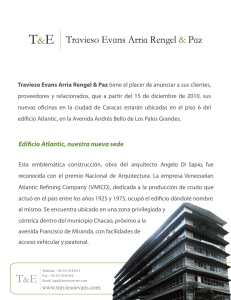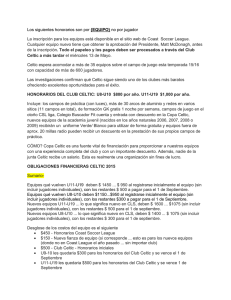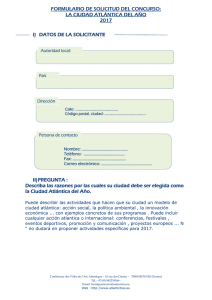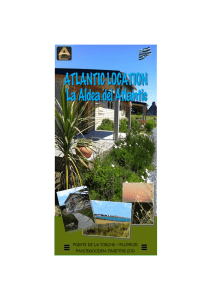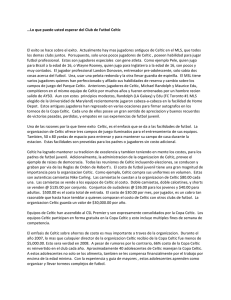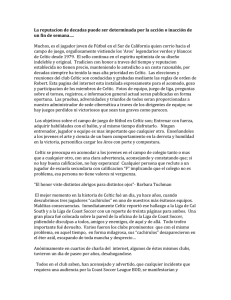Celts from the West? - Universidad Autónoma de Madrid
Anuncio
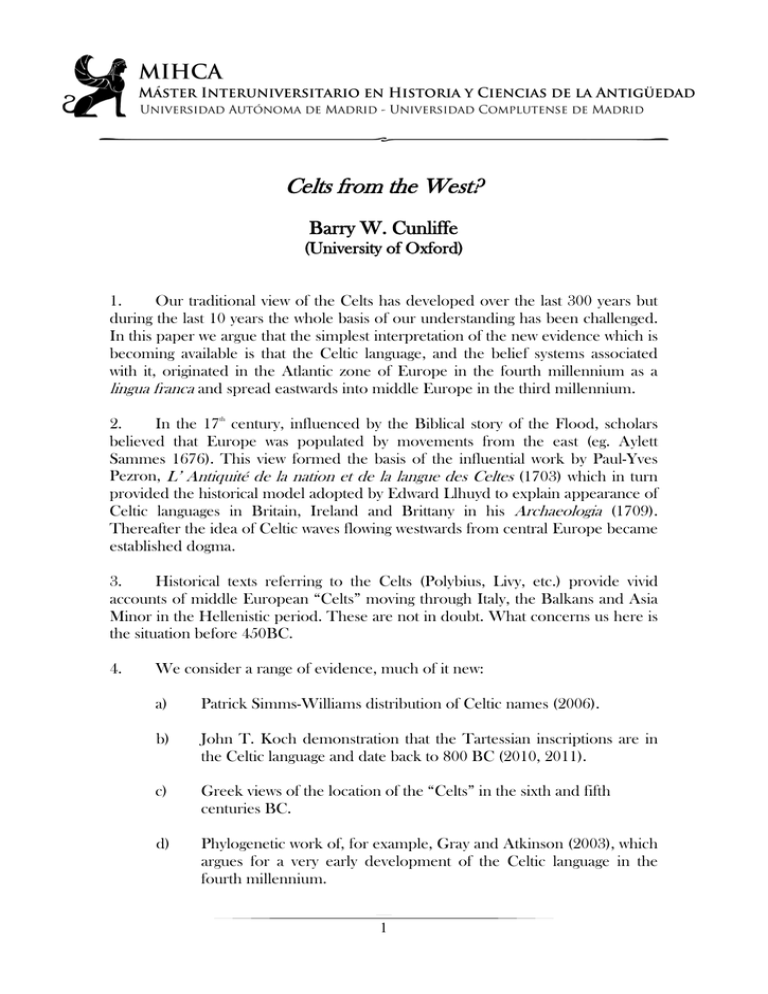
Celts from the West? Barry W. Cunliffe (University of Oxford) 1. Our traditional view of the Celts has developed over the last 300 years but during the last 10 years the whole basis of our understanding has been challenged. In this paper we argue that the simplest interpretation of the new evidence which is becoming available is that the Celtic language, and the belief systems associated with it, originated in the Atlantic zone of Europe in the fourth millennium as a lingua franca and spread eastwards into middle Europe in the third millennium. 2. In the 17th century, influenced by the Biblical story of the Flood, scholars believed that Europe was populated by movements from the east (eg. Aylett Sammes 1676). This view formed the basis of the influential work by Paul-Yves Pezron, L’ Antiquité de la nation et de la langue des Celtes (1703) which in turn provided the historical model adopted by Edward Llhuyd to explain appearance of Celtic languages in Britain, Ireland and Brittany in his Archaeologia (1709). Thereafter the idea of Celtic waves flowing westwards from central Europe became established dogma. 3. Historical texts referring to the Celts (Polybius, Livy, etc.) provide vivid accounts of middle European “Celts” moving through Italy, the Balkans and Asia Minor in the Hellenistic period. These are not in doubt. What concerns us here is the situation before 450BC. 4. We consider a range of evidence, much of it new: a) Patrick Simms-Williams distribution of Celtic names (2006). b) John T. Koch demonstration that the Tartessian inscriptions are in the Celtic language and date back to 800 BC (2010, 2011). c) Greek views of the location of the “Celts” in the sixth and fifth centuries BC. d) Phylogenetic work of, for example, Gray and Atkinson (2003), which argues for a very early development of the Celtic language in the fourth millennium. 1 The best-fit hypothesis to contain all this new evidence is that the Celtic language developed in the Atlantic zone of Europe and spread eastwards. 5. To test this, and to consider the cultural context, we look at the archaeological background of Atlantic Europe in the crucial period from the fifth to first millennium BC focusing in particular on the themes of connectivity and mobility. We consider the maritime and riverine networks which facilitated connectivity over the longue durée and identify four major phases of development. • Establishing connectivity: 5000 – 2700 BC The formation and consolidation of social networks • Escalating mobility: 2700 – 2200 BC The Beaker phenomenon and its interactions with the Corded Ware/Single Grave complex • Consolidation: 2200 – 800 BC The development of the Atlantic Bronze Age system • Dislocation and isolation: 800 – 400 BC The fragmentation of the Atlantic system Finally, we argue that the Celtic language developed as a lingua franca in the period 5000 – 2700 BC and spread eastwards with the Beaker ideology in period of escalating mobility in the mid third millennium. It flourished and developed during the Atlantic Bronze Age. In the first millennium BC the breakdown of “international systems” in the Atlantic zone led to the development of distinctive forms of Celtic e.g. Goidelic and Brythonic. This new paradigm best fits the totality of the evidence currently available and offers an agenda for further work. 2 ¿Celtas de Occidente? Barry W. Cunliffe (Universidad de Oxford) 1. Nuestra visión tradicional de los celtas se ha conformado a lo largo de los últimos 300 años, pero en los últimos 10 años todas las bases de nuestra compresión han sido desafiadas. En este estudio proponemos que la interpretación más sencilla de las nuevas evidencias disponibles es que la lengua celta, con los sistemas de creencias asociados a ella, se originó en el área atlántica de Europa en el cuarto milenio como lingua franca y se difundió hacia el este, a Centroeuropa, en el tercer milenio. 2. En el siglo XVII, influenciados por la historia bíblica del Diluvio, los eruditos creían que Europa había sido poblada por migraciones procedentes del Este (así, Aylett Sammes 1676). Esta visión fue la base de la influyente obra de Paul-Yves Pezron, L’ Antiquité de la nation et de la langue des Celtes (1703), que a su vez proporcionó el modelo histórico adoptado por Edward Llhuyd para explicar la aparición de las lenguas célticas en Britania, Irlanda y Bretaña en su Archaeologia (1709). En adelante, la idea de las oleadas célticas que fluyen hacia el oeste desde Europa central se convirtió en dogma establecido. 3. Los textos históricos referentes a los celtas (Polibio, Livio, etc.) proveen de vívidos relatos de “celtas” centroeuropeos moviéndose por Italia, los Balcanes y Asia Menor en el período helenístico. Éstos no se ponen en duda. Lo que nos concierne aquí es la situación antes del 450 a.C. 4. Consideramos una serie de evidencias, en gran parte nuevas: a) La distribución de nombres célticos de Patrick Simms-Williams (2006). b) La demostración de John T. Koch de que las inscripciones tartésicas revelan una lengua céltica y se remontan al 800 a.C. (2010, 2011). c) Los testimonios griegos sobre la localización de los “celtas” en los siglos VI y V a.C. 3 d) El estudio filogenético de, por ejemplo, Gray y Atkinson (2003), que demuestra un desarrollo muy temprano de la lengua céltica en el cuarto milenio. La hipótesis que mejor se ajusta a todas estas nuevas evidencias es que la lengua céltica se desarrolló en el área atlántica de Europa y se difundió hacia el oeste. 5. Para demostrar esto, y considerar el contexto cultural, examinaremos el trasfondo arqueológico de la Europa atlántica en el periodo crucial entre el quinto y el primer milenio a.C., centrándonos en particular en las cuestiones de conectividad y movilidad. Consideramos las redes marítimas y fluviales que facilitaron los contactos de longue durée e identificamos cuatro grandes fases de desarrollo. • Establecimiento de contactos: 5000-2700 a.C. La formación y consolidación de las redes sociales. • Escalada de la movilidad: 2700-2200 a.C. El fenómeno Campaniforme y sus interacciones con la cultura de la Cerámica Cordada/Enterramientos individuales • Consolidación: 2200-800 a.C. El desarrollo del sistema de la Edad del Bronce Atlántica • Dislocación y aislamiento: 800-400 a.C. La fragmentación del sistema atlántico Finalmente, sostenemos que la lengua céltica se desarrolló como lingua franca en el periodo 5000-2700 a.C. y se difundió hacia el este con la ideología del Campaniforme en el periodo de escalada de la movilidad a mediados del tercer milenio. Para florecer y desarrollarse durante la Edad del Bronce Atlántica. En el primer milenio a. C. la ruptura de los “sistemas internacionales” en el área atlántica determinó el desarrollo de formas específicas de lengua céltica, como el goidélico o el britónico. Este nuevo paradigma es el que mejor se ajusta a la suma de evidencias actualmente disponibles y ofrece una agenda para futuros estudios. 4 Apoyos bibliográficos: CUNLIFFE, B.W. Facing the Ocean. The Atlantic and its peoples, 8000 BC to AD 1500. (Oxford: Oxford University Press). 2001. CUNLIFFE, B.W.: Europe between the Oceans. Themes and variations: 9000 BC- AD 1000. (New Haven & London: Yale University Press). 2008. CUNLIFFE, B.W. (ed.) (2010): Celtic from the West. Alternative perspectives from archaeology, genetics and literature. (Oxford: Oxbow Books). 2010. Lección inaugural del Curso 2011-2012 (Vª Edición) del Máster Interuniversitario en Historia y Ciencias de la Antigüedad (MIHCA) Universidad Autónoma de Madrid - Universidad Complutense de Madrid Salón de Actos de la Facultad de Filosofía y Letras (UAM) Lunes 26 de septiembre de 2011, 11 horas 5
